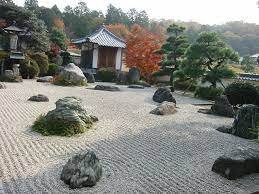Japanese Zen gardens, renowned for their simplicity, tranquility, and harmonious design, embody a profound philosophy that integrates nature, spirituality, and aesthetics. Rooted in Zen Buddhism, these gardens offer a space for contemplation, meditation, and a deep connection with the natural world. Let’s delve into the fundamental design principles that define Japanese Zen gardens.
I. Simplicity (Kanso)
Zen gardens epitomize simplicity, adhering to the principle of Kanso. A minimalist approach is taken, emphasizing only essential elements. This simplicity fosters a serene atmosphere, allowing visitors to experience tranquility without unnecessary distractions.
II. Natural Elements (Shizen)
The inclusion of natural elements is pivotal in Japanese Zen gardens. Rocks, gravel, sand, and plants are carefully chosen and arranged to mimic natural landscapes like mountains, islands, or flowing water. This incorporation of nature promotes a sense of balance and harmony.
III. Asymmetry (Fukinsei)
Rejecting perfect symmetry, Zen gardens embrace asymmetry to evoke a sense of natural beauty. This principle, Fukinsei, acknowledges the imperfections in the world, emphasizing balance through irregularities rather than uniformity.
IV. Stillness and Movement (Seijaku)
Zen gardens skillfully balance stillness and movement. Raked gravel or sand represents the dynamic flow of water, while the surrounding rocks and plants embody stillness. This interplay reflects the concept of Seijaku, creating a harmonious and meditative environment.
V. Symbolism and Metaphor (Yugen)
Yugen, the principle of profound beauty and mystery, infuses Zen gardens with symbolism and metaphor. Elements like stepping stones may represent a spiritual journey, while carefully placed rocks can symbolize islands in a sea of gravel, invoking a deeper, hidden meaning.
VI. Enclosure and Privacy (Enso)
The design of Zen gardens often includes elements like bamboo fences, walls, or strategically placed vegetation to create a sense of enclosure and privacy. This principle, Enso, fosters a feeling of retreat, ensuring that the garden becomes a secluded sanctuary.
VII. Borrowed Landscape (Shakkei)
Shakkei, or “borrowed scenery,” integrates external elements into the garden design. Views of mountains, trees, or neighboring structures become part of the composition, expanding the visual space and connecting the garden to the larger world.
VIII. Pathways (Roji)
Paths in Zen gardens are carefully designed to guide visitors through the space. These Roji, or dewy paths, are often composed of stepping stones or gravel, leading individuals on a contemplative journey and encouraging a slow, mindful pace.
IX. Arrangement of Rocks (Ishigumi)
Rocks hold significant importance in Zen gardens. Ishigumi, the art of arranging rocks, involves careful consideration of size, shape, and placement. These rocks symbolize mountains and islands, contributing to the overall balance and aesthetic of the garden.
X. Seasons and Change (Ten-Tei)
Zen gardens embrace the concept of impermanence and the beauty of seasonal change. The Ten-Tei principle encourages the adaptation of the garden to the evolving seasons, with blooming flowers, changing foliage, and shifting patterns in the sand or gravel.
XI. Open Spaces (Ma)
Zen gardens incorporate open spaces strategically. These empty areas, known as Ma, are as crucial as the filled ones, providing a sense of pause and contributing to the overall composition. Ma invites contemplation and emphasizes the significance of the surrounding elements.
XII. Maintenance and Ritual (Bakoku)
The meticulous maintenance of Zen gardens is a ritualistic practice. Bakoku emphasizes the importance of regular care, symbolizing the impermanence of all things and the ongoing journey of self-discipline and mindfulness.
XIII. Mindful Design (Kufu)
Every aspect of a Zen garden is intentionally designed. The principle of Kufu involves careful planning and execution, ensuring that each element contributes to the overall harmony and spiritual resonance of the space.
XIV. Zen Philosophy Integration
Beyond design principles, Japanese Zen gardens integrate the philosophical essence of Zen Buddhism. The gardens serve as a reflection of the impermanence of life, the interconnectedness of all things, and the pursuit of enlightenment through mindful observation.
XV. Conclusion
Japanese Zen gardens transcend mere landscaping; they are profound expressions of a philosophy that seeks harmony, simplicity, and connection with nature. By embracing these design principles, individuals can create spaces that not only soothe the senses but also invite contemplation, mindfulness, and a deeper understanding of the world and oneself.






